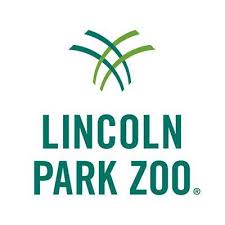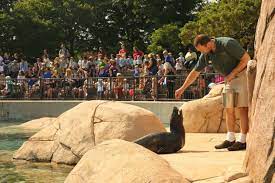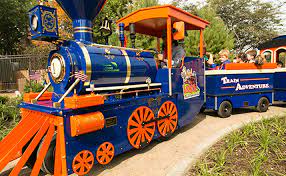The Lincoln Park Zoo's vision is to "Inspire communities to create environments where wildlife will thrive in our urbanizing world".
Location: 2001 N Clark St, Chicago, IL 60614
About the Zoo
The Lincoln Park Zoo was founded in 1868. It all started when two pairs of swans arrived at Lincoln Park as a gift from New York's Central Park. Visitors of Lincoln Park Zoo can learn about diverse species from around the world. The zoo is home to many different types of animals ranging from small fish to large mammals such as polar bears. Lincoln Park Zoo houses several animal exhibits that is home to nearly 200 unique species. These exhibits include the Camel and Zebra Exhibit, Farm-in-the-Zoo, Helen Brach Primate House, Hope B. McCormick Swan Pond, Kovler Seal Pool, McCormick Bird House, Pepper Family Wildlife Center, Pritzker Family Children's Zoo, Regenstein African Journey, Birds of Prey, Center for African Apes, Macaque Forest, Small Mammal Reptile House, Penguin Cove, Arctic Tundra, and Waterfowl Lagoon. There are also hundreds of plant species living at the zoo. Visitors can discover natural plant ecosystems, see beautiful flowers, trees and other flora around the zoo. As the zoo evolved, it became one of the most popular cultural destinations in Illinois and is the only privately owned, free zoo in the country. https://www.lpzoo.org/
History of the Lincoln Park Zoo
The Lincoln Park Zoo was founded in 1868 making it the fourth oldest zoo in North America. It is the largest public park in Chicago and stretches for seven miles. In 1868, two pairs of swans arrive as a gift from New York's Central Park. The birds symbolize the beginning of Chicago's free zoo. in 1870, the zoo builds it's first animal house. During this time, bison, foxes, elk, deer, wolves, eagles, a puma, peacocks, and two turtle doves are donated to the zoo. In 1878, commissioners decree the zoo must always remain free. The Lincoln Park Zoo remains free today due to the strong community and donors. In 1879, the original sea lion grotto was constructed. In the 1890s, two sea lions escaped and wandered into a Clark Street restaurant.
Lincoln Park Zoo's first director was Cyrus DeVry. He was hired in 1888 and was a charismatic leader and the first public face of the zoo. He assisted in the creation of the McCormick Bird House Exhibit built in 1904. This Exhibit is Lincoln Park Zoo's most historic building and houses several bird species from the tropics, seashores, forests, wetlands, and savannas. Visitors at this exhibit can see bird species that are extinct, threatened, or endangered, and learn about how Lincoln Park Zoo is working towards preserving and protecting that species.
Lincoln Park Zoo has several historical architecture facts that remain an important part of the zoo's history. In 1889, the first restaurant opened called the "Red-Roofed Cafe". It is now known as Eadie Levy's Landmark Cafe and remains open to serve refreshments to zoo visitors. In 1908, Cafe Brauer opened. It was closed and reopened 50 years later in 1990. This landmark was restored and reopened by the Lincoln Park Zoological Society. In 1912, the Lion House opened. It is now known as Pepper Family Wildlife Center and houses several big cat. In 1920, a full-scale replica of a Norse Viking ship sailed from Norway to Chicago for the 1893 World’s Columbian Exposition. It was installed on zoo grounds and remained open until 1994. In 1962, Mayor Richard J. Daley helps open Farm-in-the-Zoo, a replica of a working Midwestern farm.
Lincoln Park Zoo focuses on the innovation of it's resources to provide the best care for the zoo animals. In 1964, the zoo’s volunteer program begins. Shortly after, in 1970, the zoo welcomed a new gorilla member named Kumba. He is the first western lowland gorilla born at the zoo. In 1976, the zoo opened their first hospital. A few years after this, preventative medicine was introduced and more educational programs were created. Today, there are several science centers at the zoo and conservation centers.
The mission of Lincoln Park Zoo is "dedicated to connecting people with nature by providing a free, family-oriented wildlife experience in the heart of Chicago and by advancing the highest quality of animal care, education, science, and conservation." The core commitments of the zoo are care, conservation, and community.
Visiting the Zoo
Lincoln Park Zoo Hours
Open every day
- Gates 10:00am - 5:00pm
- Buildings: 10:00am - 4:30pm
- Farm-in-the-Zoo: closes at 4:30pm
Parking
The parking lot entrance is located at Fullerton Parkway and Cannon Drive (2400 N. Cannon Drive).
- Hours: 6:00am - 11:00pm
- Rates: Free for the first half hour. Rates range from $20-35 per day
Admission Rates
- Free
Zoo Membership
By becoming a zoo member, you're funding learning programs, supporting animal care and conservation, and keeping the zoo free. All members receive free or discounted parking year round, access to the member lounge, invitations to member-only events, discounts on gift shops, restaurants, stroller parking, and much more.
- General Individual Membership: $69
- General Household Membership: $95
- General Safari Membership $189
- Donor Club: $365+
- Chairman's Council: $25,000+
Activities
Seal Training and Feeding
Learn how to take care of the Seal by watching this daily training session. Located at the Kovler Seal Pool. Training sessions begin at 11:00am and 2:00pm.
Ape Cognition and Care
Discover the surprising methods Lincoln Park Zoo uses to learn about and care for great apes. Located at the Regenstein Center for African Apes. Activity begins at 1:30pm Monday through Friday.
Lionel Train Adventure
The trackless, 28-passenger train travels over bridges, past the forest and canyon scenery, before returning to the station. It features passenger cars, a coal car, and a wheelchair-accessible caboose.
- Tickets: $4 for 1, $36 for 10 or $69 for 20
AT&T Endangered Species Carousel
Ride a Chicago Landmark with 48 hand-carved and hand-painted replicas of threatened animal species.
- Tickets: $4 for 1, $36 for 10 or $69 for 20
Lincoln Park Zoo FAQ
How much does it cost to visit Lincoln Park Zoo?
Lincoln Park zoo is free and has been since the opening in 1868.
How does the zoo stay free?
80% of the zoo’s operating costs are supported by zoo members, donors, and visitors. A subsidy from the Chicago Park District covers the remainder.
What are the benefits of zoo membership?
Lincoln Park Zoo members benefit from free and discounted parking, invitations to member-only events, discounts at gift shops, restaurants, stroller parking and much more. For more details on memberships visit this link - https://www.lpzoo.org/join/become-a-member/
What animals can visitors see?
There are hundreds of animals at Lincoln Park Zoo. Currently, the zoo has about 1,100 animals and about 200 species. These animals include critically endangered species and species that are extinct in the wild.
Can visitors meet the animals?
Lincoln Park Zoo has several habitat exhibits that allow visitors to get up close to the animals. There are also interactive programs at the zoo that include Groom the Goats, Feed the Cows, Feed the Chickens, and Malott Family Penguin Encounter.
How does the zoo help animals?
The zoo has an Animal Care Staff that provides world class care to all of the animals. Zoo scientists and educators also lead wildlife conservation projects and educational initiatives to benefit the animals.
Can I take photos at the zoo?
Lincoln Park Zoo encourages guests to take photos for personal use, however, commercial photography and filming is prohibited without a permit.
Who do visitors contact for media inquires?
For all media inquiries, visit the zoo’s Pressroom page for contact information and media assets.
How can visitors provide feedback?
Visitors can comment on their experience at Lincoln Park Zoo during a normal visit, email [email protected] or call 312-742-2355. To comment on a free or ticketed event, email [email protected].
How can visitors get more information about the zoo?
If visitors have a question, concern, or need while visiting the zoo, they can get assistance by visiting Searle Visitor Center or finding a nearby staff member or volunteer wearing a green polo marked with the Lincoln Park Zoo logo. For general information, visit the About the Zoo page or call 312-742-2000.
References








